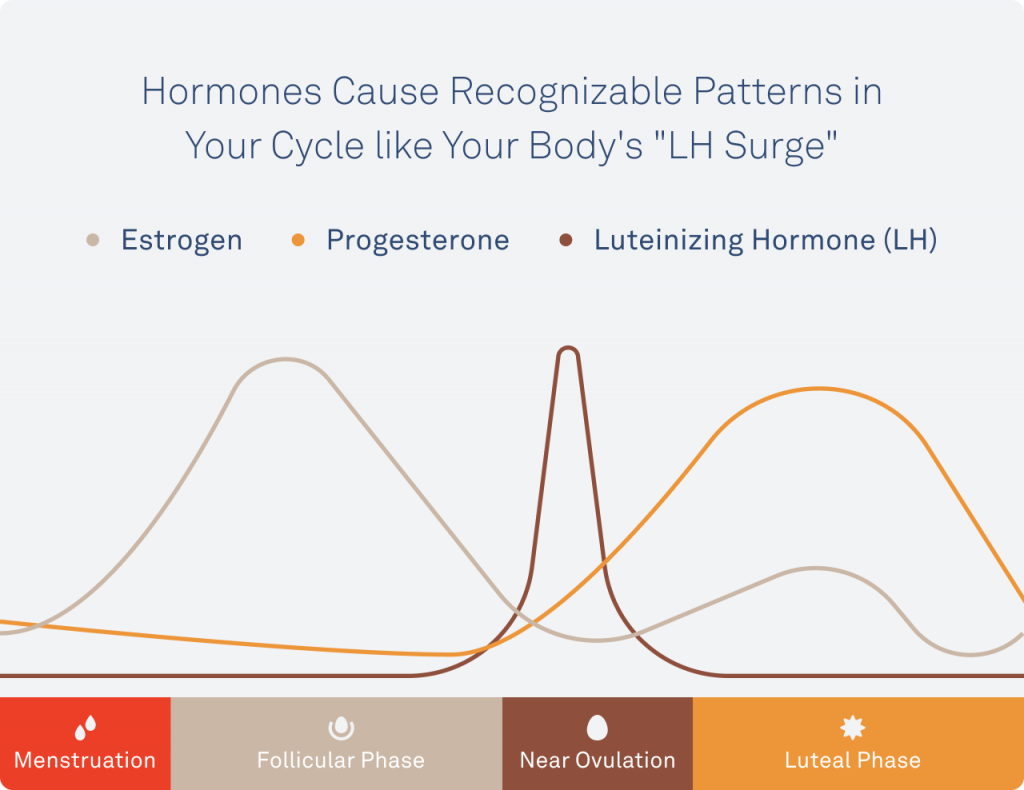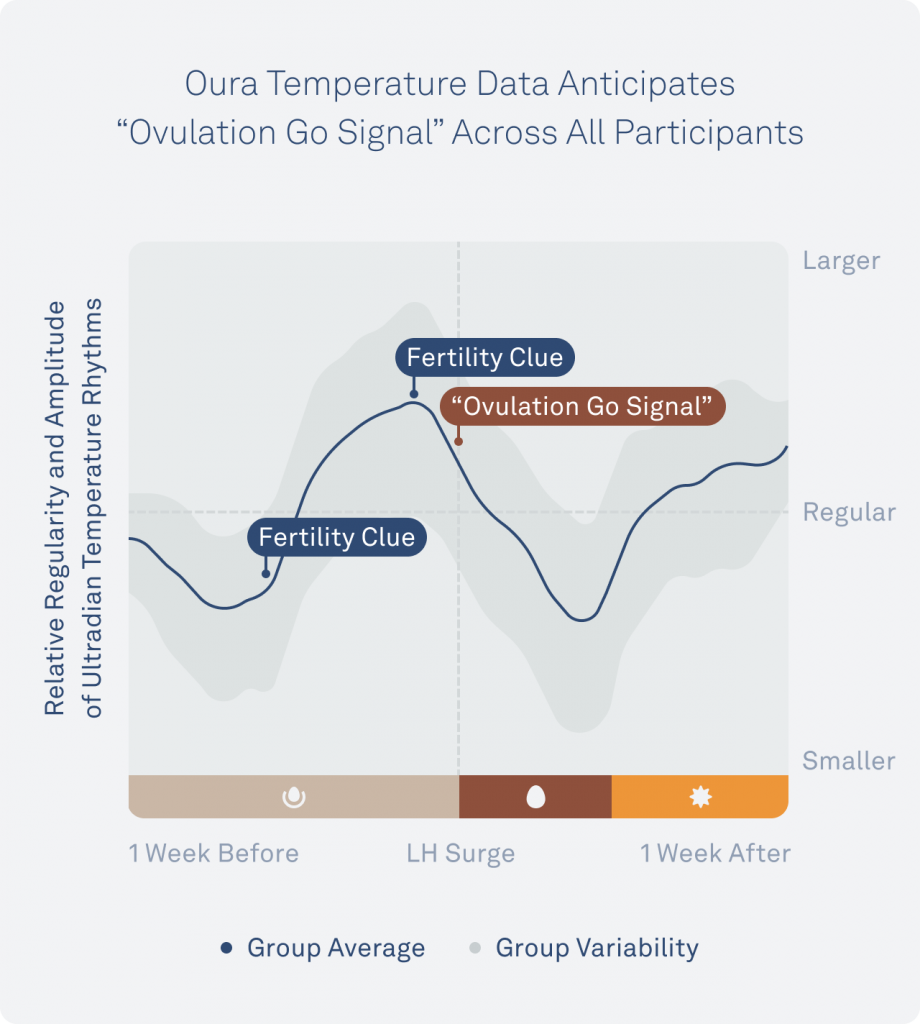Researchers in the Kriegsfeld Lab at the University of California, Berkeley (UCB), in collaboration with Precision Analytical and Oura, have published the results of QCycle, a project aimed at identifying signals that can predict female fertility. The researchers were looking for signs of the LH surge, a sudden hormone increase that acts as the “go signal” for the release of an egg (ovulation).
The QCycle team discovered that by looking at Oura Ring patterns for the first 1-2 weeks of the menstrual cycle, they could anticipate the LH surge days in advance for 100% of participants.
Oura was able to detect changes in heart rate variability (HRV) and daytime skin temperature that signal an upcoming LH surge.
“Many fertility algorithms limit accuracy by using last month’s ‘weather’ to predict what will happen this month, and it can only tell you for sure that you were fertile after the fact,” says Dr. Azure Grant, the lead researcher.
For example, traditional fertility awareness tools face timing challenges when identifying your LH surge. These tools try to estimate when the LH surge will occur based on previous months’ oral temperatures, identify that the LH surge is already in progress using a hormone test, or retrospectively confirm that ovulation occurred with a sonogram.
By contrast, QCycle shows that it is possible to forecast the LH surge in advance, noninvasively, with a tool like Oura Ring, which provides personalized and continuous temperature data. The results of this study pave the way for more accurate methods of cycle tracking and natural family planning by showing us the power of understanding what’s happening in our bodies as it happens.
READ MORE: How Your Menstrual Cycle Impacts Your Entire Body

Participant-Led Research
QCycle was an innovative form of “participant-led” research where the women generating the data were active contributors to the study. Women from the Quantified Self community joined QCycle via an organization called Open Humans.
Open Humans enabled the participants to share discoveries and learn about themselves in-depth while providing direct Oura data access to the researchers.
In total, 25 women — representing a variety of cycle lengths, cycle regularity, ages, and perimenopausal symptoms — joined the study to contribute to Oura metrics, LH surge test results, and personal observations. Additionally, the participants generated daily hormone data via an innovative form of urine testing called “Dutch Test.”
This open collaboration between a curious community, a non-profit, private companies, and a university enabled the participants to pursue personal questions while contributing to a scientific discovery.
| Member Tip: Oura members can track their menstrual cycle on Oura using Cycle Insights. For members who are pregnant, you now have access to Pregnancy Insights, to offer an additional layer of support and guidance throughout your pregnancy. |
Study Findings
QCycle leveraged Oura as the only consumer wearable to generate research-grade, minute-by-minute temperature readings and an unparalleled high sampling rate of 250Hz for nightly resting heart rate (RHR) and heart rate variability (HRV). Having access to such strong, continuous streams of data enabled the researchers to go beyond measuring averages (e.g., 98 degrees, 50 bpm) to start analyzing subtle, wavelike patterns in moment-to-moment data known as “ultradian rhythms.” These patterns can only be monitored with data points taken at fast intervals (e.g., every 5 minutes) like Oura Ring.
If you have ever noticed that your hunger comes and goes throughout the day or that you have “bouts” of energy rather than a steady stream, what you are sensing are your ultradian rhythms. These wavelike patterns of hormones, body temperature, breathing rate, neurotransmitters, heart activity, and more repeat every few hours. The pattern of these waves gives us information about our bodies and, in this case, helps identify key events in female fertility:
- Pre-Ovulation: Leading up to ovulation, the body produces larger and more regular ultradian temperature and HRV wave patterns. The study used Oura to spot the start of that process (Clue 1), as well as when temperature and HRV waves are at their biggest and most regular (Clue 2).
- Perimenopause: In women approaching menopause (perimenopausal) these HRV and temperature wavelike patterns became more variable.

The Implications of the Findings
In the future, this kind of research can improve the tools available to consumers.
“We were really excited to see our preclinical work on the neural and hormonal mechanisms underlying ovulation translated into a promising and convenient method of fertility prediction,” says Professor Kriegsfeld, senior author of the study. “The findings highlight how medically accurate devices like Oura can be used to conveniently collect high-resolution data that enables women to monitor and anticipate future changes in their reproductive physiology.”
“A tool that can help you get ahead of ovulation, simply by wearing a ring, is incredibly useful. Many of us were not taught how our menstrual cycles can affect metabolism, sleep, or thinking,” comments Grant. “Having accurate, up-to-date information could give you more agency in planning both the minor and major decisions in your life.”
It’s about changing the way we think about our cycles.
The Next Steps
Oura is committed to helping pursue solutions on the cutting edge by ensuring that research is expanded and validated to represent our diverse user base.
Research like QCycle paves the way for tools like Oura to move towards more personalized, current, and accurate ways of tracking the menstrual cycle. While Oura doesn’t currently have a cycle tracking feature, we are actively working with researchers and users alike to understand how Oura data can help people monitor their ovulatory cycles, birth control methods, pregnancies, hormone status, post-partum life, and more.
Research like this helps inform our teams and could certainly impact the features we bring to market in the future. We are eager to carry out that work with you – the Oura Community, so that these results can be tested in a larger, more diverse population.
RELATED: UCSD Study Shows Clear Oura Temperature Increase After Conception




